#Bucharest Village Museum
Text

Casa Lăzeşti
Transylvania, Alba County
Lăzeşti, Romania
This 19th century farmhouse, locally called the Casa Locuinţă, is part of a farmstead (gospodărie) relocated from Lăzeşti, in the Apuseni Mountains, to the Village Museum in Bucharest. The building consists of a ground level cooper's workshop with living quarters above. A covered exterior stair leads to a projecting gallery (prispă) supported on brackets and covered with a flared extension of the roof. The lower level is constructed of lime-washed brick, while the upper level is of horizontal wood construction, covered by a steep hipped roof clad with pine shingles. (photo 2000)
39 notes
·
View notes
Note
Hello! I believe you are Romanian?? Do you have any recommandations on what to see/do in Bucharest? (if you ever visited there??)
i am! and i have visited the capital quite a few times. i'm not an expert on Bucharest, since it's so big and there's so much to explore (i still have so much to see myself), but depending on how much time you have on your hands, here are some recs (and even a non-rec, you'll see lol):
the "Old Town", also known as "Centrul Vechi", there's some lovely belle epoque architecture, mixed in with some byzantine elements, west meets east kind of thing, really narrow detours and zig-zaggy alleys (you'll see this mixture throughout Bucharest: try the big, pretty boulevards like Calea Victoriei and Lipscani)
the Atheneum is also very pretty (near the Roman Square - "Piața Romană") and i'd also recommend the "Suțu Palace" (Palatul Suțu).
the "Village Museum" (Muzeul Satului), this really cool open-air museum all about traditional village life throughout the centuries in Romania, it's quite lovely
the National Art Museum (Muzeul Național De Artă) which is HUGE and wonderfully stocked, but you'll need like...almost a whole day to see all of it. the building is also really beautiful. if you have more time, you should also check out a smaller branch called "Muzeul Colecțiilor de Artă" (museum of art collections), where you'll find really interesting art donated by important Romanian families
definitely try to see the Stavropoleos Monastery, one of the oldest places in the city. it is a jewel. you'll love it there (and it's right next to the national history museum). if you visit Romania there will be no shortage of churches and monasteries to see. i'm def biased but we have some of the most beautiful monasteries in the world. you'll see a lot of cool churches/monasteries in Bucharest.
"Hanul Lui Manuc" (Manuc's Inn) is one of those big historical sites you should cover (and it's also a restaurant!); it's a very old inn going back to the beginning of the 19th century and some fascinating stuff went down between its walls (we were still under Ottoman rule when it was built, and it hosted an important peace treaty between the Ottomans and the Russians). i haven't dined there in ages, but i hear the food's still good!
you should check out some of the big parks like Cișmigiu and Herăstrau. there's also this tinier park i'm really fond of called IOR (also called Titan), but that's if you have more days to spare.
on that note, and because this is turning into an eclectic list, try to get to "Lacul Morii" if you can (literally the "mill lake"); it's this lovely and eerie lake that has this very 'abandoned Greek temple' feel to it, due to the architecture and the wilder vegetation on its one island/peninsula (called the island of angels). if you're into spooky/eerie vibes, i highly recommend it, since in order to engineer this lake, a church and a cemetery had to be demolished during the communist regime and uhhh, you definitely feel a vibe when you walk around that area.
speaking of communism, there will be plenty of museums and national houses that you can visit which will tell you about that era in Romanian history if you're interested, but err, you can see it as you walk around town; the eastern bloc soviet architecture is everywhere in the city planning and the grey apartment blocks. most towns in Romania have this overlapping architectural style and most of us have a hate/love relationship to it. since Bucharest is one of the safest capitals in Europe, you can explore neighborhoods and streets outside the big tourist centers, just to get a taste of that. you'll see really lavish streets, and then really industrial-looking, kinda grundgy areas and sometimes there will be combos of really old and really new, or really beautiful and really ugly. it has its own charm. don't stray too far tho
i'd recommend using the pretty good subway system to get to various places (buses and trams are usually super-packed and while there's not so much pickpocketing going on here as in, say, a much more touristy place like Rome, it helps to be vigilant). if you use the subway system, try to see the "Piața Romană" platform (in sector 1) because it's one of the strangest subway platforms in the world. it was basically built in secret during communism, because the dictator's wife didn't understand the purpose of that particular area having a subway line, and so the architects and engineers had to do a very hush-hush hatchet job, which resulted in a place with really narrow platforms and this unique look to it. it has those eerie/spooky vibes i love
DON'T, imo, waste your time on the Parliament Palace, infamously known as "Casa Poporului" (the people's house). you'll hear a lot about this building and how it's the second largest in the world, but it's an ugly behemoth that Ceaușescu had built out of mania and ego and the city and ppl suffered for it. it's the most ironic name you could give a parliament building. it's ugly and lame. skip it.
there are many other places to see, but last thing i'll mention here if you can swing it is the newly refurbished Marmorosch Blank Bank, which is now a hotel & restaurant. it's jaw-dropping, gorgeous kitsch and super bougie and expensive, but if you can look around it's worth it.
anyway, hope you have fun and that you get smth out of the experience! (don't worry about language hick-ups, btw, a lot of Romanians, especially younger ppl, know pretty good English)
16 notes
·
View notes
Video
youtube
Get ready to explore one of Bucharest’s Romania's most beloved attractions! The National Village Museum "Dimitrie Gusti" is not just a park; it's an open-air ethnological museum with ancient buildings that will transport you through the ages. From the 17th to the early 20th century, this unique and captivating place offers a fascinating glimpse into Romanian village life. Join us as we uncover its location, access, operating hours, ticket prices, and, most importantly, the treasures waiting to be discovered inside!
2 notes
·
View notes
Text

30 March 2017 | Prince Charles, Prince of Wales is given some shoes during a visit to the Village Museum (Muzel Satului) on the second day of his nine day European tour in Bucharest, Romania. (c) John Stillwell - WPA Pool/Getty Images
2 notes
·
View notes
Photo




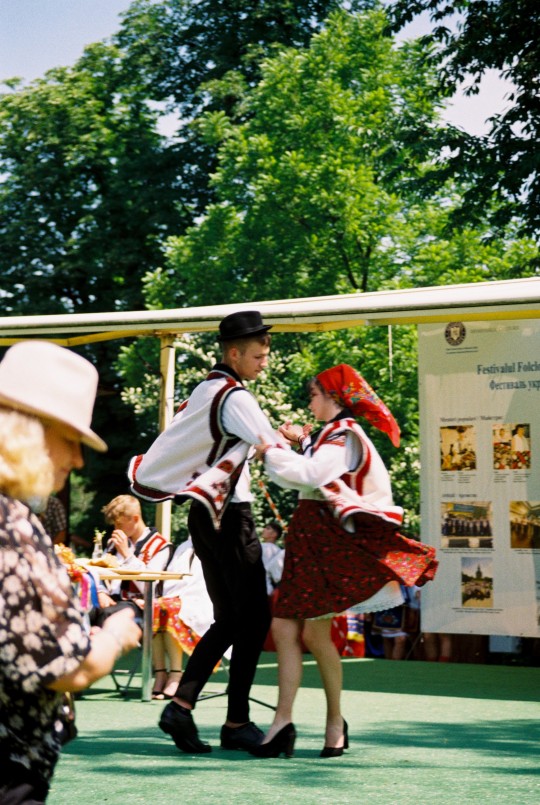


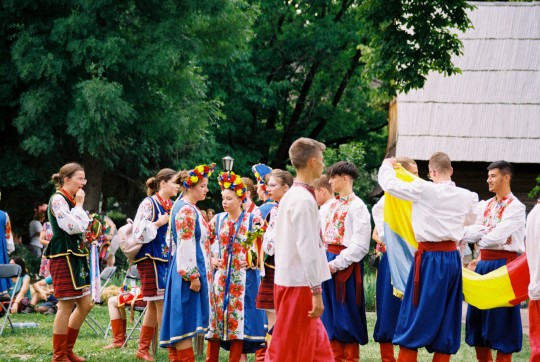
Folklore Festival of Ukrainians in Romania
“Dimitrie Gusti” National Village Museum, Bucharest, Romania
4 June 2022
Nikon FM2 / Fujicolor 200
82 notes
·
View notes
Text
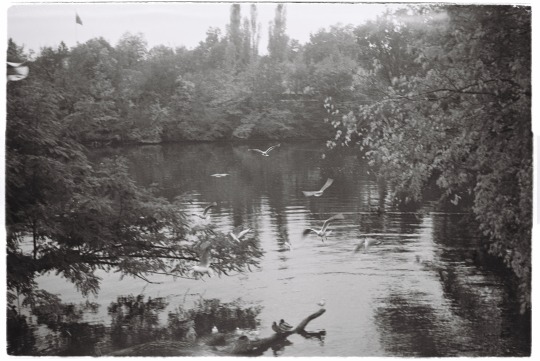
I was constrained by a theme I had to follow to capture some landscapes,, but as I was in the middle of Bucharest, without any ways to get to it's outside shell, I had to improvise and think about what makes a landscape a landscape. I got to the conclusion that nature is mandatory,, and also the space in the distance. I tried to fake all of that with this river arm behind the National Village Museum, on a foggy day. The birds were paid actors.
Hanimex, Ilford XP2 super 400 (I think)
©: @aduda
#birds#landscape#fake landscape#bw#black and white film#blackandwhite#black and white#35mm film#film photography#filmisnotdead#analog#analog photography#black and white analog#nature#trees#natural#park#water#eye of water
10 notes
·
View notes
Text
I see that no one’s made a post about the Pietroasele Treasure (Tezaurul de la Pietroasele), also known as the Hatching Hen with the Golden Chicks (Cloșca cu puii de aur).
Until the discovery of Tutankhamun's tomb in 1922, it was considered the largest trove in the world. In addition, its discovery sent European treasure hunters into a frenzy!
The story of the treasure begins in the Romanian village of Pietroasele...
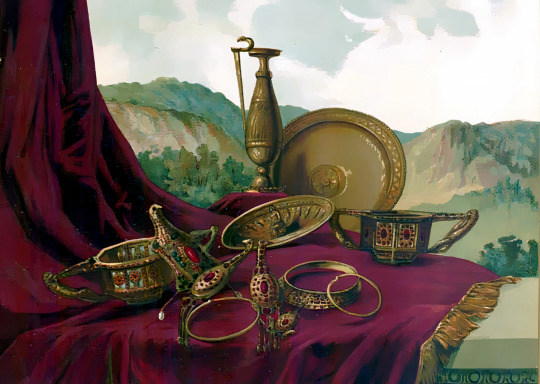
Illustration by Henric Trenk for the cover of the first volume Le Trésor de Pétrossa published by Alexandru Odobescu in 1889. Full illustration here.
On 25 March 1837, two stonemasons, Ion Lemnaru and Stan Avram, discovered the treasure under a foothill. The exact location of the find is one kilometre away from the ruins of the Pietroasele Roman castra. According to the stonemasons, the trove consisted of 16 to 26 pieces.
Eventually, the treasure was bought by a merchant called Verussi. In order to make the pieces easier to transport, Verussi split them with an axe. The 12 pieces recovered by the authorities remained damaged until 1867, when they were restored for the first time by a Parisian jeweller on the occasion of the Paris International Exhibition.
For first time, Romania had its own pavilion, and the treasure was called "the most beautiful flower of the Exhibition". Even Napoleon III took a liking to it. German professor Rudolf Neumeister attributed the treasure to Athanaric, the fourth-century Visigoth ruler who had passed through present-day Romania. The hypothesis was picked up by Alexandru Odobescu, who published his monograph Le Trésor de Pétrossa in 1889.
The treasure’s journey to its present resting place wasn’t easy. Alexandru Odobescu was accused by the Romanian press of that time of having "sold, pawned or alienated" the trove. After a six-month tour of London, Vienna and Paris again, the trove returned to the Museum of Antiquities in Bucharest.
In 1875, the trove was stolen and further damaged. In 1884, it was caught in a fire and thrown out the window to safety. In the same year, it underwent its final restoration by Paul Telge, a Berlin goldsmith who also worked for the Romanian royal family.
In 1917, Romania’s treasure, including the Pietroasele trove, was sent to Moscow for safekeeping. It was not until 1956 that the Soviet Union returned the trove. To this day, the rest of Romania’s treasure remains in Moscow.
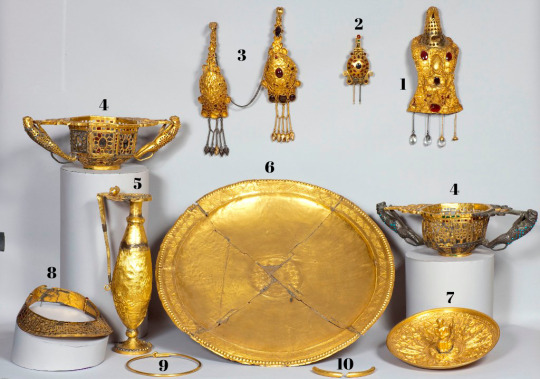
Nowadays, the treasure can be seen at the National Museum of Romanian History in Bucharest. It consists of:
a large fibula in the shape of an eagle,
a small fibula,
two medium-sized fibulae,
two polygonal baskets,
an oenoche,
a tray,
a patera or a round sacrificial dish,
a wide necklace,
a plain necklace,
a necklace inscribed with runes.
Sources: 1, 2, 3 .
#romania#romanisme#pietroasele treasure#tezaurul de la pietroasele#cloșca cu puii de aur#my entries#it's one of my favorite stories#but it also makes my blood BOIL#how can you SPLIT something like this with an AXE#I know his ultimate goal was to melt it but...I just can't process it#my brain short circuits every time I think about it#last time I saw it irl was last year I believe (?)#don't be fooled by the pictures the treasure is HUGE#- looks at the places where the other gemstones should have been -#-sigh- Henric Trenk's illustration is the closest we'll ever get to seeing the original
3 notes
·
View notes
Text
Architecture
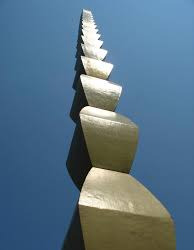

Coloana Infinitului (The Endless Column)- Constantin Brancusi
Brancusi was a Romanian sculptor, painter and a photographer who made his career in France,In 1918 he sculptured a remarkable statue. The sculpture is 98-foot-tall (30 meter) column of zinc, brass-clad, cast-iron modules threaded onto a steel spine. .This Endless Column is the earliest extant version of a motif to which Brâncuși would return over the course of his career. In previous years Brâncuși had used a doubled pyramid as a base for his sculptures, but he realized that this abstract block could be multiplied into a pillar form, a fully realized work in its own right. It is carved from oak. This was his first ways and ideas he had in mind before the original was made.To this day, their are pieces of his work in New York museums and different sculptures he had designed.
Fortified churches
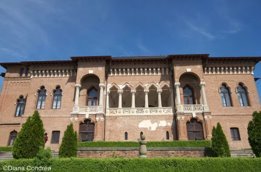

Constantin Brâncoveanu was the Prince of Wallachia between 1688 and 1714.He also created a beautiful ‘Brancoveanu’ architectural style. You can admire it in many old churches from Bucharest and also at Mogosoaia Palace. This is shown in the first picture.
The fortified churches from Transylvania are some of the most authentic and inspiring travel attractions in Romania. A fundamental part of the Saxon heritage that transforms the region into a great destination.
Biertan was centuries ago a prosperous village competing with nearby Mosna and Medias for regional control. The construction of an imposing fortified church was yet another element used to increase its chances in this political race.You may see this church in the second picture.The Biertan church one of the few that preserves its original altar, pews, and stone carved pulpit, all from the 16th century. Not to mention its unique locking system of the vestry door and the marital prison organised in one of its towers.
Luminita Machedon and Scoffham, E.R. (1999). Romanian modernism : the architecture of Bucharest, 1920-1940. Cambridge, Mass.: Mit Press.
2 notes
·
View notes
Text
Sibiu & Sibiel 🇷🇴
Hey there, friends, it’s another blog post from your friendly neighborhood social worker clinician traveling through Romania!
So it’s another kind of short post today but that’s mainly just because we only did stuff in the morning and then the afternoon I spent most of the time just resting. But this morning was actually really fun because we got to go and see this brilliant, open air walkable museum outside of Sibiu; the ASTRA Museum of Traditional Folk Civilization. The museum was established as a "shelter for keeping the past." Wander among windmills, houses, cottages, workshops, and exhibits highlighting historic objects and architecture from all around Transylvania. The grounds included actual homes and buildings from different villages and neighborhoods around Romania & Transylvania that have been transported and restored so that visitors are able to see the types of architecture, living arrangements and art styles across history & from all across the country. Mom and I got to take a lot of photos of some of the different buildings, as well as going to see the unique Romanian style for houses in the smaller villages, as well as the fences, the churches, and even the school houses. After our tour museum, we of course had to stop at the gift shop because well duh!

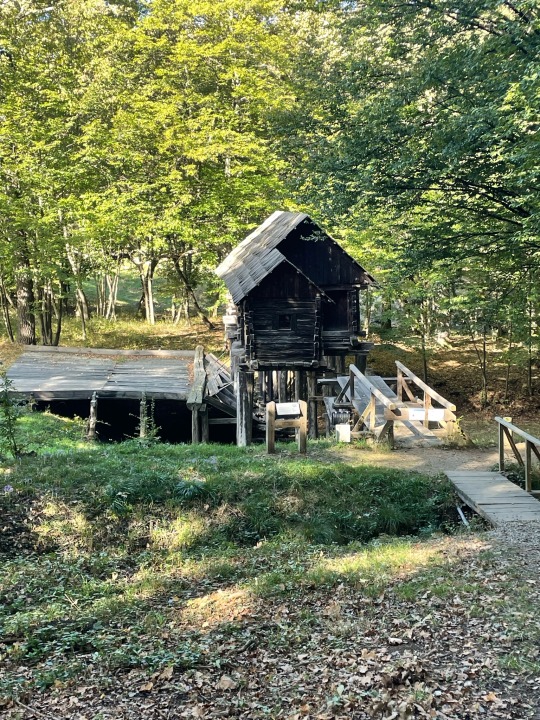



And then a tour group went and toured this lovely little museum in Sibiel, Zosim Oancea Museum of Icons on Glass, which is dedicated to the ancient practice of painting on glass. This small museum outside of an old orthodox church contained over four dozen different unique pieces of artwork, depicting biblical stories and saints on glass painted with naturally formulated paints from plants and food items. Unfortunately, we couldn’t take any photos because you have to pay an extra 15 lei in order to take photos but I will just tell you to look it up online because it is pretty cool.
After our tour of the glass museum, we then headed to a 100% pure authentic Romanian lunch, which was absolutely delicious. I do have to say on this trip for the past 3 1/2 weeks I’ve been spoiled when it comes to the food that I’ve been able to eat . This lunch included the Romanian specialty dish which involves mincemeat wrapped in cabbage with a side of polenta. Not usually what I’d order, but it was quite delicious. And we also got to taste some freshly made wine made from grapes that are grown right outside the restaurant .
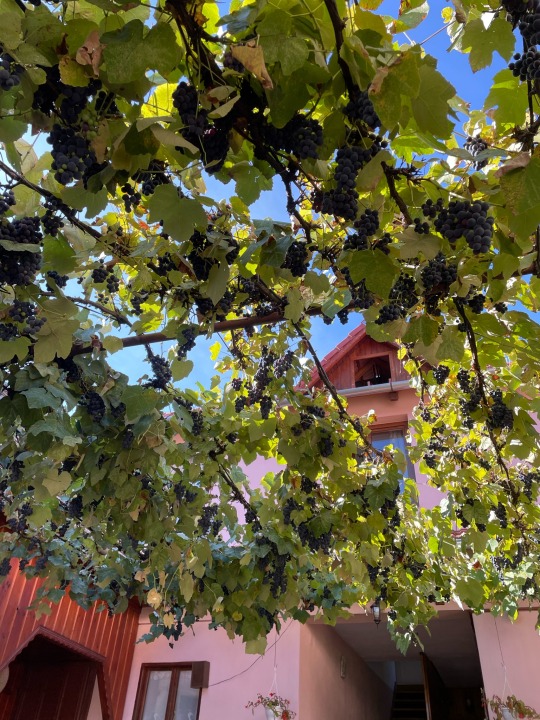
We headed back to Sibiu. Our tour guides told us that we had the rest of the afternoon to do as we wish. Mom and Pat and I all really kind of needed the afternoon to re-organize our bags and to rest a little bit so we all three went to our rooms to take care of our own stuff. Myself I spent the time re-organizing my suitcase since tomorrow we head back to Bucharest to an airport hotel, and then a very very early Monday morning flight back to the states.
That’s the news for today; don’t be surprised if tomorrow’s also kind of a short report as well since I think our plan is just to tour one more orthodox church, and then we head to Bucharest and try to catch a few hours of sleep before we have to head out to our very early morning flights home. But of course, if there is anything to share, you know, I will be happy to include it in my stories.
Till tomorrow my gentle readers
Lowry 💜
0 notes
Text
0 notes
Video
youtube
Music and Images of Deep Relaxation - Palm Sunday - Village Museum
Deep relaxation music and images of Palm Sunday - The National Museum of the Village "Dimitrie Gusti" - Bucharest - Romania. A glimpse at the flower festival fair.
0 notes
Text
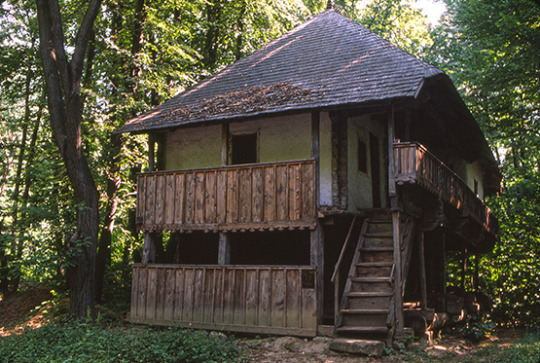
Casa Beuran
Oltenia, Gorj county
Budieni, Romania
This 19th century two-story house was relocated to the Village Museum in Bucharest. The walls are built of horizontal oak plank with interlocking corner joints, sealed with a plaster coating on the upper, living floor. The hipped roof is clad with pine shingles. The house has wood-framed galleries on two sides, with railings of vertical board and batten. The gallery along the longer side wall appears to have a raised edge for sitting.
(photo 2000)
35 notes
·
View notes
Text
Cat Paradise
Valeria Duca (Moldovian, b. 1995)

Valeria Duca started her career at an early age. Her first exhibition took place when she was only 12 years old in her hometown, Chisinau, generating appreciation for her abstract work and her sense of colour. Recognition came early with her participation at the Venice Biennale in 2011, marking Moldova's debut on the international art stage. At 17 Valeria moved to the UK, where she studied Art History at the University of St Andrews. After living and painting professionally in Oslo, Norway for some years she has recently moved to Washington DC.
Valeria’s works have evolved over the course of her thirteen-year career, from expressive abstract painting towards figurative realism. Not a student of an academy or part of an atelier, her realism is riddled with symbolism in an attempt to create visual metaphors. A narrative depicting, if not a descent into madness, then at least a blurring of the edges of normality, at times flirting with the surreal.
Her works have been purchased for the permanent collections of a number of Eastern European museums: the Museum of History and Archaeology in Moldova, the Museum of Visual Art in Galati, Romania, the Museum of Western and Eastern Art in Odessa, Ukraine, the Museum of the Village, Bucharest, Romania, the Folk Art Museum in Constanta, Romania and the Palace of Parliament, Bucharest, Romania..
0 notes
Text
August Activity
In the second half of August (17.08-1.09) I went on a summer camping trip to Romania with my scout group. Throughout that trip we have visited multiple cities including Budapest (18.08 and 31.08), Bucharest (21.08), Brasov (19.08 and 20.08), and Sibiu (29.08 and 30.08). There we have visited many museums, historical locations and landmarks as well as other tourist attractions, e.g. the Valea Cetatii Cave near Rasnov or an abandoned mine in the Fagaras mountains in the administrative area of Viştişoara village.
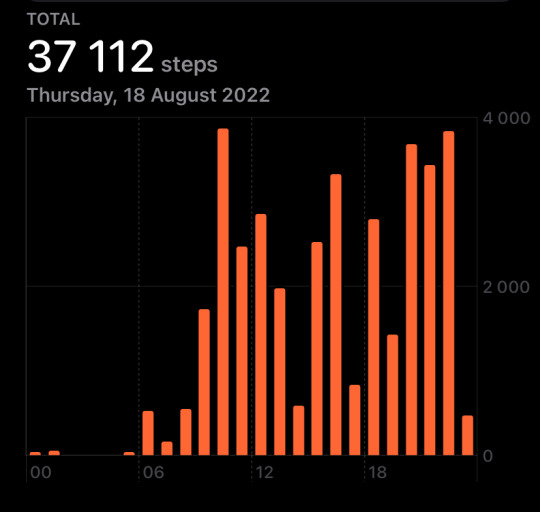

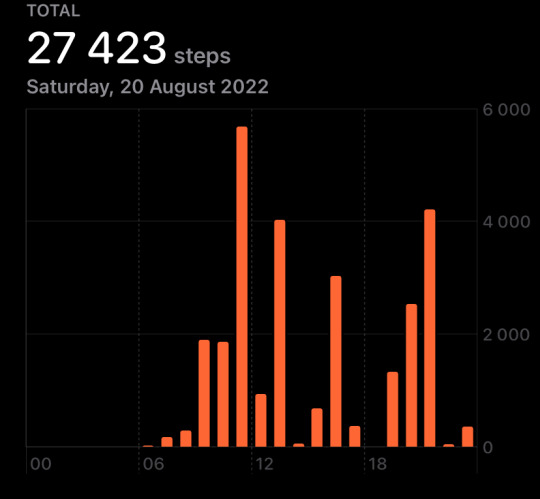
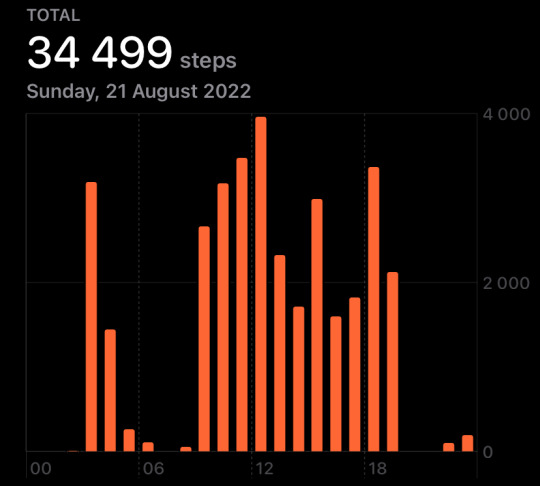

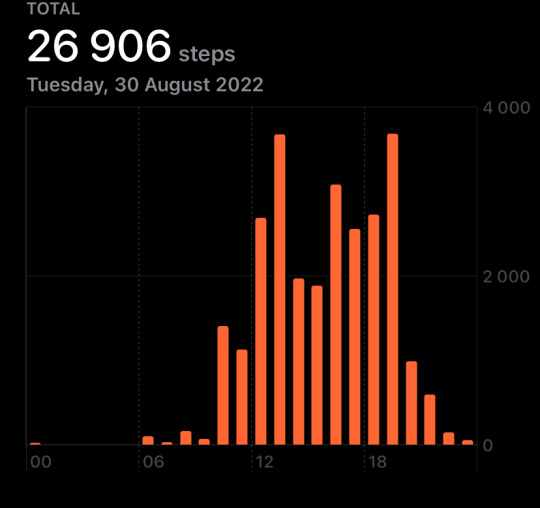
0 notes
Photo

30 March 2017 | Prince Charles, Prince of Wales visits the Village Museum (Muzel Satului) on the second day of his nine day European tour in Bucharest, Romania. (c) John Stillwell - WPA Pool/Getty Images
1 note
·
View note
Text
Dimitrie Gusti National Village Museum Bucharest Romania
Dimitrie Gusti National Village Museum Bucharest Romania
Dimitrie Gusti National Village Museum – Romanian Insider
The Bucharest Village Museum is a marvel! It’s an open-air ethnographic museum in the middle of the bustling Romanian capital situated on 35 acres along the shores of Herăstrău Lake. The museum “recreates the past three centuries of the Romanian village” in one of Bucharest’s main green spaces.
Wooden Church Maramureş Răpciuni Neamț…

View On WordPress
#Alexandru Odobescu#Berbeşti#Berbeşti Houses#Bessarabia#Braşov Dragomireşti#Bucharest National Park#Bucharest Village Museum#Bukovina#Bukovinian and Bessarabian Refugees#Buzau#Carol II Park Bucharest#Danube Delta#Dimitrie Gusti National Village Museum Bucharest#Dobrogea#Dragomireşti Maramures#Elisabeta Palace#Ethnographic Museum of National Decorative and Industrial Art Bucharest#Ethnographic Museum of Transylvania#Ethnography Department of the Museum of Alexandria#Folklore and Traditional Life of the Romanian Countryside#Folklorist and Sociologist Dimitrie Gusti#Fundu Moldovei#Gorj#Gorj County#Henry H. Stahl and Victor Ion Popa Craftsmen#Herta Region#Herăstrău Lake and Park#Herăstrău Park#Hoia Park Cluj#House from Apuseni Mountains
1 note
·
View note